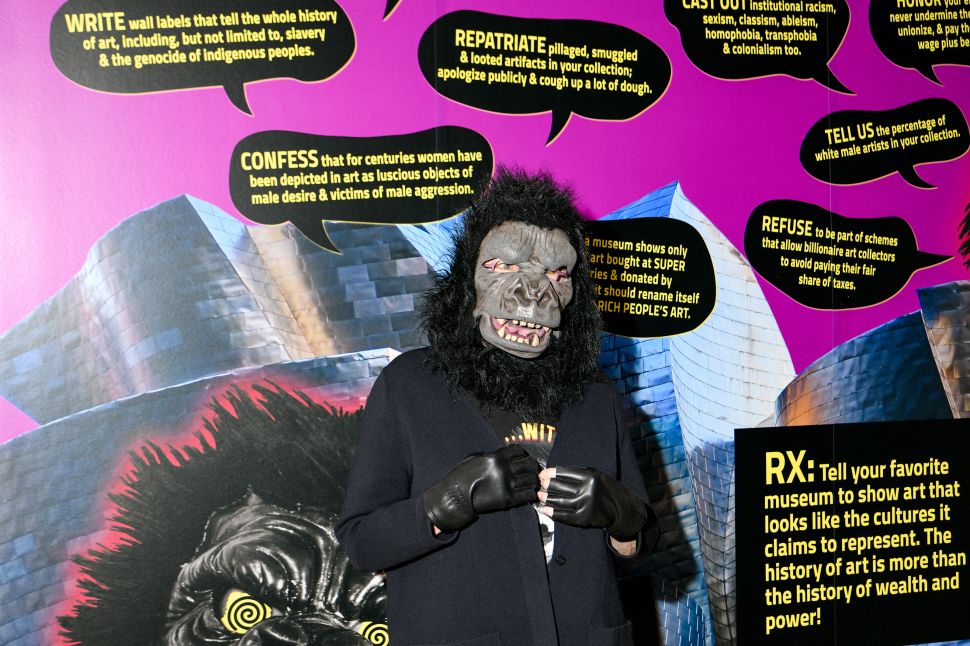You probably know the Guerrilla Girls for their dissemination of embarrassing statistics that make us wish the art world was a better place. (Those unfamiliar should look into their Public Service Messages from the late 1980s or the Pop Quiz series from the early 1990s.) Now, the Guerrilla Girls are having their first-ever commercial gallery exhibition at Hannah Traore Gallery in New York City, which recently opened and runs through March 29. Titled “Discrimi-NATION: Guerrilla Girls on Bias, Money and Art,” it celebrates the group’s culture jamming interventions that have been shaking up the art world, nationally and internationally, for more than three decades.
This anonymous group of feminist artists has been fighting sexism and racism since they formed in 1985 after picketing outside of the Museum of Modern Art the year before. They were protesting the fact that “An International Survey of Recent Painting and Sculpture” was billed as a show of the most important artists of the era but only included thirteen women and eight people of color out of 165 artists featured.
Part retrospective, part reminder of just how messed up things still are, “Discrimi-NATION” walks visitors through the various ways the art world hasn’t moved past its history of overt race and gender discrimination. Some of the aforementioned works from the ‘80s and ‘90s are on view, and it’s jarring to consider both how far we’ve come and how much remains to be done to address art’s glaring inequities, past and present.
SEE ALSO: Afghanistan’s Art Scene Weighs in On Taliban Move to Ban Images of Living Things
Though the MoMA protest accomplished very little, the group born out of it and its members have, in the years since, been some of the only women unafraid to stand up and speak out against major museums with all-male boards of directors—not to mention male curators and male-artist-dominated exhibitions. But has much changed since 1985? The Guerrilla Girls wear gorilla masks in public and use pseudonyms for interviews; some of the group’s members have adopted the monikers of great women artists like Alice Neel, Gertrude Stein, Frida Kahlo, Harriet Tubman and Kathe Kollwitz. Observer had the lucky opportunity to interview the pseudonymous Kollwitz about the exhibition, the art group’s long-standing legacy and whether Artforum has changed at all.
You’re in L.A., are you okay?
I’m okay, and thank you for asking, but so many have lost everything. This includes many artists. If your readers want to help, they can donate to this GoFundMe for artists and art workers.
The exhibition is focused on discrimination in the art world. How do you feel about it in the context of the moment we’re in today?
Today, there are many more women and artists of color in galleries and museums, and the Guerrilla Girls have helped make that happen, but there is still a long, long, long way to go.
Why is this the first time your poster works are being shown in a commercial gallery, and why did you want to work with Hannah Traore?
The Guerrilla Girls do more than twenty museum exhibitions around the world each year, but we rarely do gallery exhibitions. Hannah’s show is our first solo show in a New York City art gallery. She contacted us, we met with her and we proposed “Discrimi-NATION” as the title and subject of the show. By the way, we think it’s significant that “DISCRIMINATION” contains the word ‘nation.’
What kind of hell did you raise with your Public Service Messages back in the 1990s?
We began street postering in 1985, and to our surprise, our posters had an instant effect. Our plan was to create political art that used persuasive advertising strategies, showed people something they didn’t know before and had the power to change people’s minds. We received many positive responses from artists… and many negative responses from museums, galleries and art critics.
Did you ever get any responses from your pink postcard series, like the note to curator Thomas Krens, What’s New and Happening at the Guggenheim for the Discriminating Art Lover? from 1992?
Oh yeah, there was a response. He had planned to open a downtown Guggenheim with an inaugural exhibition of four white male artists. After we bombarded him with our “Dear Thomas Krens” postcards, he added a single woman artist, Louise Bourgeois. Guess what… one is not enough! We were also part of a huge demonstration outside the museum and gave out paper bag gorilla masks for the protesters to wear.
Is Artforum any better now that they brought on Tina Rivers Ryan as editor-in-chief?
There have often been women editors at art magazines, including at Artforum, which we used to call ArtforHIM. The problem is that magazines make money by charging art galleries for ads. And—surprise—they tend to review exhibitions at those galleries.
How are art museums more inclusive today? And how are they worse?
Museums need billionaires to keep them going. If that’s the system they’re stuck with, at the very least they should kick out the donors whose businesses make the world a worse place.
Where do you get your statistics?
Museum and gallery websites are our go-to. We also have spies inside institutions who feed us info. And something else happens often today: museums ask us to examine their collections and criticize them right on their own walls or on giant banners on their facades, and they supply the statistics.
If there’s one thing you could change about the art world right now, what would it be?
You can’t change the art world’s history of racism and sexism, but you can do everything you can to make people aware of it.

